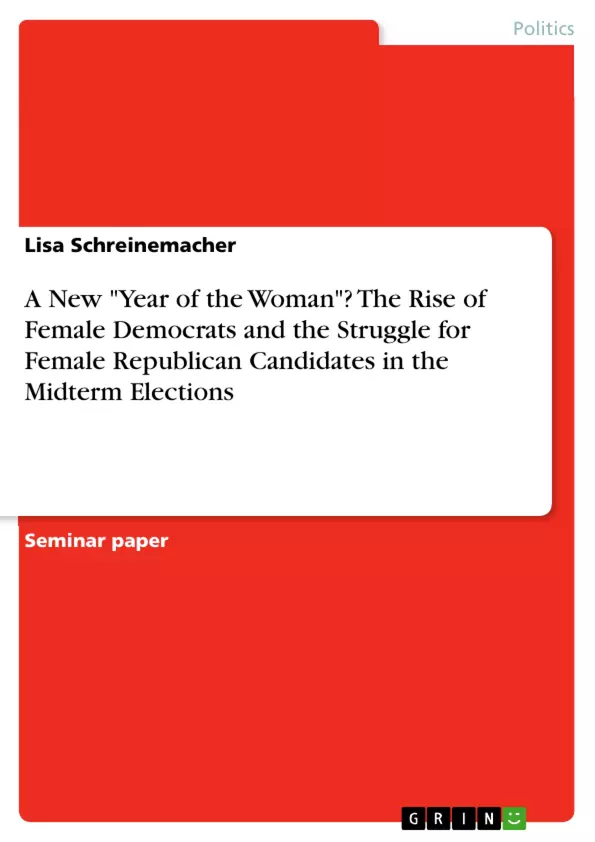This study is concerned with the question in how far the presidency of Donald Trump creates advantages or disadvantages for female candidates for the midterm elections. Firstly, there will be a chapter that deals with the initial situation which was created when Donald Trump became the 45th President of the United States. It will give some background information about the lewd history and indecent behavior of Trump towards women, which leaked to the media during his presidential campaign. Chapter three will provide an analysis of two female Democratic Party candidates and their advantages for the midterm elections in November 2018. The chapter will present Kyrsten Sinema who is running for the U.S. Senate to represent the State of Arizona and Chrissy Houlahan, who is running for the House seat of the 6th Congressional District of Pennsylvania.
Another chapter will focus on difficulties that Republican female candidates have to face and present Diane Harkey who is running for a House seat in California’s 49th Congressional District and Martha McSally, also running for the Senate seat to represent the state of Arizona. Within these subchapters, the strength and weaknesses of each candidate will be pointed out and how each of them make use of the presidency of Donald Trump. Finally, the last paragraph of this term paper will be a conclusion, which sums up the results achieved and gives an outlook for future research on women in Congress.
Inhaltsverzeichnis (Table of Contents)
- Introduction
- Initial Situation After Donald Trump's Election
- The Rise of Female Democratic Party Candidates
- Kyrsten Sinema
- Chrissy Houlahan
- The Struggle for Female Republican Candidates
- Diane Harkey
- Martha McSally
- Conclusion
Zielsetzung und Themenschwerpunkte (Objectives and Key Themes)
This term paper examines the impact of Donald Trump's presidency on the emergence of female candidates in the 2018 US midterm elections. The paper analyzes the potential advantages and disadvantages for female candidates, particularly focusing on Democratic and Republican candidates.
- The historical context of women's representation in US politics
- The impact of Donald Trump's behavior and rhetoric towards women on the political landscape
- The strategies and challenges faced by female candidates from both Democratic and Republican parties
- The role of gender dynamics and societal perceptions in shaping electoral outcomes
- The potential for increased female representation in Congress in the wake of the #MeToo movement
Zusammenfassung der Kapitel (Chapter Summaries)
- Introduction: This chapter provides an overview of the historical context of women's participation in US politics, highlighting the significance of the 1992 "Year of the Woman" and the current situation leading up to the 2018 midterm elections.
- Initial Situation After Donald Trump's Election: This chapter examines the public reaction to the allegations of sexual misconduct against Donald Trump and the impact of his presidency on women's rights and activism. It explores the role of the #MeToo movement and the resulting backlash against powerful men in the wake of Trump's election.
- The Rise of Female Democratic Party Candidates: This chapter focuses on the profiles of two prominent Democratic female candidates, Kyrsten Sinema and Chrissy Houlahan. It analyzes their campaigns, strategies, and potential advantages in the context of the Trump era.
- The Struggle for Female Republican Candidates: This chapter presents the challenges faced by Republican female candidates in the current political climate. It examines the campaigns of Diane Harkey and Martha McSally, highlighting their specific challenges and strategies.
Schlüsselwörter (Keywords)
This term paper focuses on the themes of female political representation, gender dynamics in politics, the impact of Donald Trump's presidency on women's rights, the #MeToo movement, and the 2018 US midterm elections. It examines the strategies and challenges faced by female candidates from both Democratic and Republican parties in the context of a deeply divided political landscape.
- Citar trabajo
- Lisa Schreinemacher (Autor), 2018, A New "Year of the Woman"? The Rise of Female Democrats and the Struggle for Female Republican Candidates in the Midterm Elections, Múnich, GRIN Verlag, https://www.grin.com/document/496135



